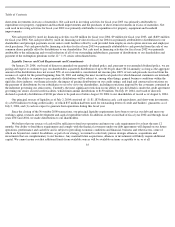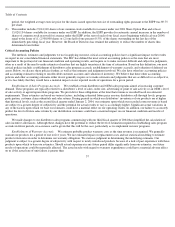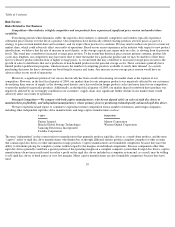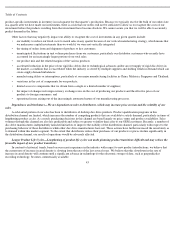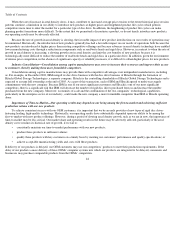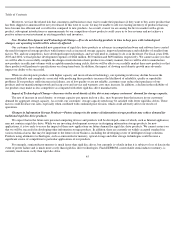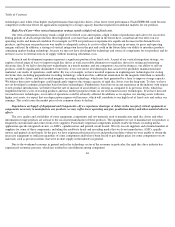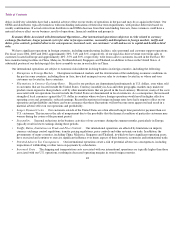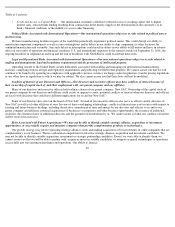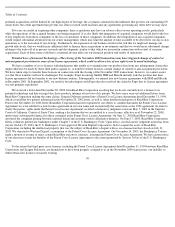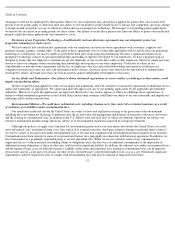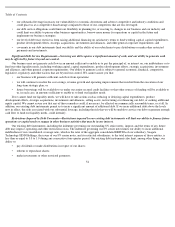Seagate 2003 Annual Report Download - page 45
Download and view the complete annual report
Please find page 45 of the 2003 Seagate annual report below. You can navigate through the pages in the report by either clicking on the pages listed below, or by using the keyword search tool below to find specific information within the annual report.
Table of Contents
When the rate of increase in areal density slows, it may contribute to increased average price erosion to the extent historical price erosion
patterns continue, a limitation in our ability to introduce new products at higher prices and lengthened product life cycles which permits
competitors more time to enter the market for a particular type of disc drive. In addition, the lengthening of product life cycles can make
planning product transitions more difficult. To the extent that we prematurely discontinue a product, or do not timely introduce new products,
our operating results may be adversely affected.
Because the rate of growth in areal density is slowing, the favorable impact of new product introductions on our results of operations may
be minimized. Historically, the introduction of new products generally has had a favorable impact on our results of operations both because the
new products are introduced at higher prices than existing competitive offerings and because advances in areal density technology have enabled
lower manufacturing costs through a reduction in components such as read/write heads and rigid discs. However, in contrast to when the rate of
growth in areal density is increasing, a slowing growth rate in areal density can limit the cost benefits of new products because it is
technologically more difficult to reduce the number of read/write heads and rigid discs in a particular drive. In addition, given the environment
of intense price competition, in the absence of significant capacity or reliability increases, it is difficult to obtain higher prices for new products.
Industry Consolidation—Consolidation among captive manufacturers may serve to increase their resources and improve their access
to customers, thereby making them more formidable competitors.
Consolidation among captive manufacturers may provide them with competitive advantages over independent manufacturers, including
us. For example, in December 2002, IBM merged its disc drive business with the disc drive business of Hitachi through the formation of
Hitachi Global Storage Technologies, a separate company. Hitachi is the controlling shareholder of Hitachi Global Storage Technologies and is
expected to assume full ownership at the end of 2005. As a part of this transaction, each of IBM and Hitachi agreed to multi-year supply
commitments with the new company. Because IBM is one of our most significant customers and Hitachi is one of our most significant
competitors, there is a significant risk that IBM will decrease the number of rigid disc drives purchased from us and increase the number
purchased from the new company. Moreover, economies of scale and the combination of the two companies’ technological capabilities,
particularly in the enterprise sector of our industry, could make the new company a more formidable competitor than IBM or Hitachi operating
alone.
Importance of Time-to-Market—Our operating results may depend on our being among the first-to-market and achieving sufficient
production volume with our new products.
To achieve consistent success with our OEM customers, it is important that we be an early provider of new types of rigid disc drives
featuring leading, high-quality technology. Historically, our operating results have substantially depended upon our ability to be among the
first-to-
market with new product offerings. However, during a period of slowing areal density growth, such as we are in now, the importance of
time-to-market may be less critical. Our market share and operating results in the future may be adversely affected, particularly if the areal
density curve resumes its historical rate of growth, if we fail to:
•
consistently maintain our time-to-market performance with our new products;
•
produce these products in sufficient volume;
•
qualify these products with key customers on a timely basis by meeting our customers’ performance and quality specifications; or
•
achieve acceptable manufacturing yields and costs with these products.
If delivery of our products is delayed, our OEM customers may use our competitors’ products to meet their production requirements. If the
delay of our products causes delivery of those OEMs’ computer systems into which our products are integrated to be delayed, consumers and
businesses may purchase comparable products from the OEMs’ competitors.
44



